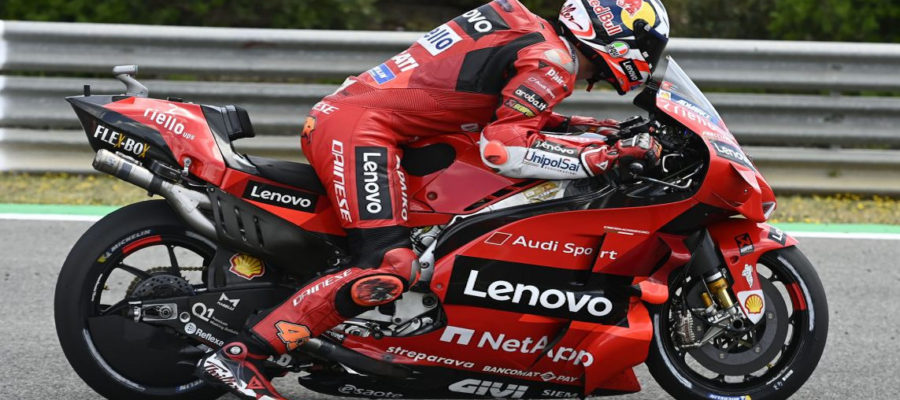Ducati are the great MotoGP innovators. But as Michael Schumacher and Jean Todt would always say “we cheat…but call it innovation”
Over the years we’ve seen some great forward thinking from the Bolognaise based team. We had the wings…which were banned – but that didn’t stop Ducati. Instead they used two wings and superglued a piece of plastic on the ends and claimed it was their fairing. The FIM scratched their heads and eventually let it go.
Then we had the aero device on the rear swing arm. The rule book clearly stated that no aerodynamic device can be attached to an unsprung part of the bike but Ducati circumnavigated this annoying rule by claiming it was to reduce tyre temperature. They even made up some graphs to prove it. Again the FIM scratched their heads and eventually let it go.
Ultimately though Ducati ran out of places to stick aero devices and instead headed down the ‘shape shifter’ route where the ride height of the bike is lowered at certain points throughout the lap to give advantages when exiting corners.
How did it all start?
A few years ago Ducati were busy testing with their then portly rider Danilo Petrucci. Over a series of laps the Italian’s mass was causing enough stress to deform the rear spring and force oil to seep out of the shock. This naturally had an overall negative effect on his lap times but, interesting, proved advantageous when driving out of slow corners.
So what happened?
The Italian team, after a light lunch of vine tomatoes and pesto, got to work devising a system where a rider could lower the rear ride height of their bike by winding up a knob on the dash. It even had an arrow on it to help Jack Miller remember which way to twist it and not to accidentally swallow it.
Initially it only worked once from the grid but instantly gave the team an advantage. As the other teams worked hard to get it banned Ducati set to work, after a light lunch of Prawn, fennel & rocket risotto, updating the system so it could be used throughout the lap.
What does the rulebook say?
Loads of stuff. Most of which is designed to be mind-numbingly boring to put people off reading it. The rest is put in by the FIM to stop Anthony West from riding again.
However the rulebook does clearly state that electronic ride height devices are banned. But knowing this Ducati, instead, decided to use mechanical and hydraulic tomfoolery to achieve their goals.
What now?
This season in testing Ducati look like they’ve taken their knowhow in cheating invention and figured out a way of mechanically adjusting the front forks as well as the rear whilst the bike is in motion. If this works it will give the team another massive advantage.
Within minutes of it being noticed Joan Mir was on the phone trying to get it banned.
Will it be banned?
Banning stuff is the great leveller. If one single team has used technical brilliance and intelligent foresight to develop a system that will give them an advantage then it’s the duty of all the other teams to club together and try to get it banned rather than spend annoying time and money developing a similar system.
The problem is that for a rule change to happen, that would ban something, all the teams must agree – and of course the team that developed the system wouldn’t allow this. This is known as the ‘Alain Prost paradox’.
So are Ducati in the clear?
Not quite. There is one way to wipe the fettuccine off the smug faces at Ducati – safety! Anything can be banned if it’s deemed unsafe. It’s the very same protocol that forced Mick Doohan to wear a hat on the podium and not expose his Oz-rules haircut to the TV audience pre-watershed.
Should enough teams moan, sulk and threaten to leave the sport (known as the Alain Prost first principle of racing) Dorna could make up some excuse that shapeshifters are dangerous and ban them.
What can Ducati next?
We asked our panel of MotoGP experts to gaze knowingly into the future and predict what Ducati will do next. Here’s the rubbish answers they came up with:
- Lowering the seat
The rider is essentially ballast. (Except in Dani Pedrosa’s case where scientifically he can only be classed as an inconsequential deflectionary force.) Lowering the rider down into the fairing would not only give a centre-of-balance advantage but also look awesome as the rider slowly descended into the bowels of the bike. The rider could then carry a pocket periscope to see over the fuel tank.
- Lengthening the bike
A similar effect to lowering the bike dynamically would be to also stretch it. This could be easily achieved with a wind-up pulley system accompanied, hopefully, with a comical squeaking sound.
We’re not sure if this is banned in the rule book but we’re pretty sure a) we can’t be bothered looking b) Ducati would find away around it. We think the crafty Italians could claim it was for safety reasons given that if a rider hit something stationary a longer bike would give the rider more time to get off.
- Letting the air out of the tyres
Another controversial method that shrewd Ducati boys could adopt would be to let the air out of the tyres when accelerating out of corners. This, like the other ideas, lower the center-of-gravity and improve drive. It would then just be a case of the rider blowing the tyres back up to the required PSI before the next corner using a cheap bit of tube bought in bulk from AliExpress.
